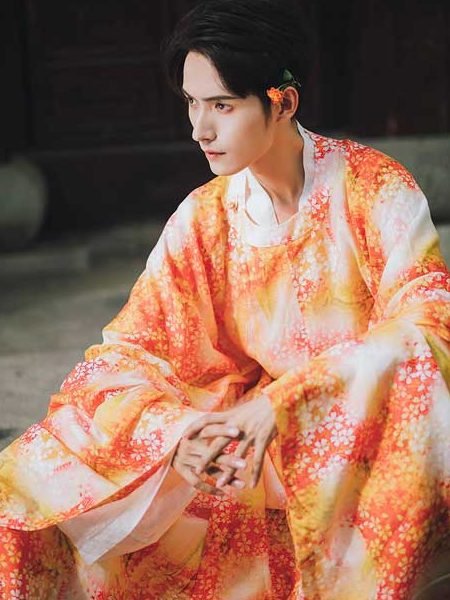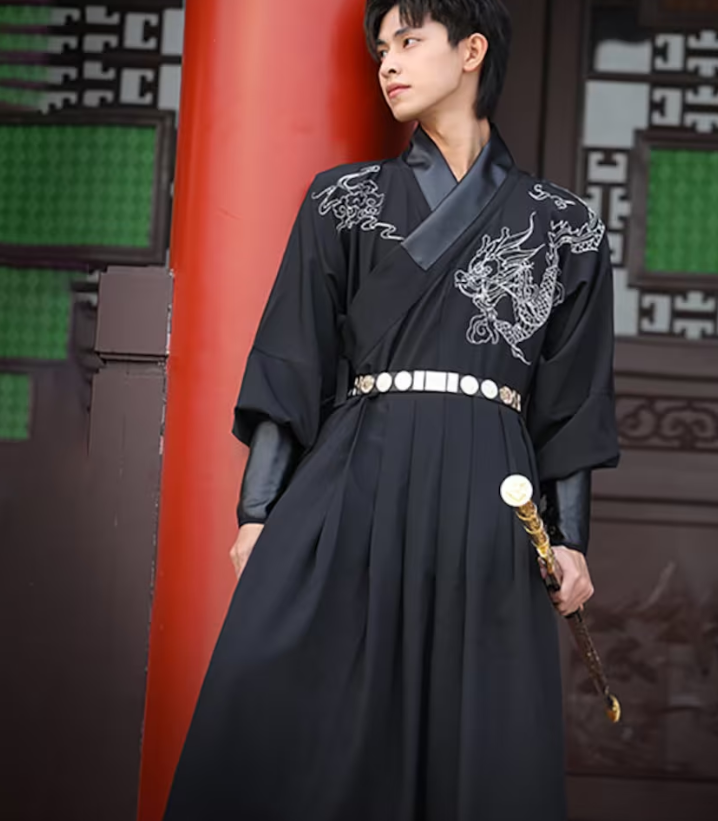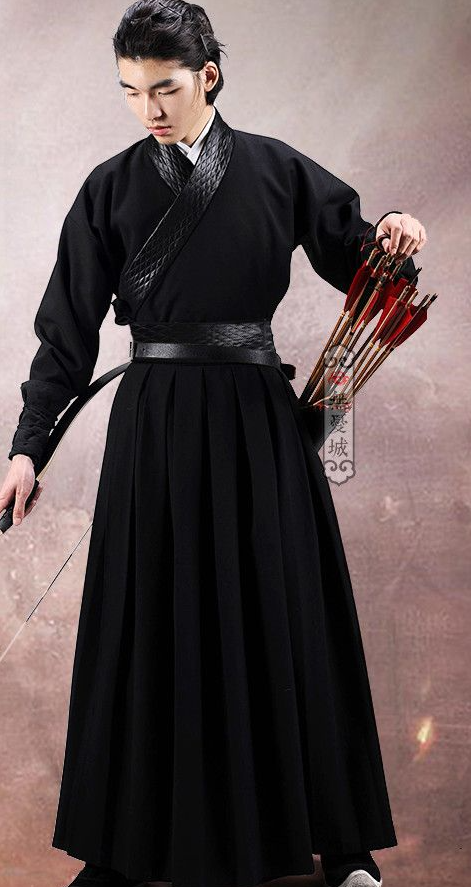To put on a male Hanfu, start by wearing the Yi (robe or tunic), followed by either the Chang (skirt) or Ku (trousers), then add the Pao (overcoat) if needed.
Components of Male Hanfu
Yi (Robe/Tunic)
The Yi is the upper garment in the Hanfu set, often compared to a robe or tunic in Western fashion. They typically come in various styles such as cross-collared, overlapping, or even straight down. The Yi can be sleeveless or come with long, flowing sleeves, depending on the design and the occasion for which it is intended. The fabric used can range from lightweight materials like silk to heavier fabrics like brocade.
- Material Choices: From breathable silk for summer days to warm brocades for winter.
- Sleeve Variations: The dramatic “water sleeves” for theatrical events or simpler, narrower sleeves for daily wear.
- Collar Styles: Choose between styles like the classic cross-collared or the straight-collared Yi.

Chang (Skirt)
The Chang serves as the bottom piece, which is essentially a skirt designed for men. It wraps around the waist and is usually tied in place with a sash. The Chang pairs extremely well with the Yi and can be equally varied in terms of materials, colors, and designs.
- Material Choices: Typically made from materials such as cotton, linen, or silk.
- Length and Design: Can be ankle-length for formal occasions or shorter for more casual events.
- Sash Details: Often tied with an accompanying sash, which can be plain or ornately decorated.
Ku (Trousers)
While the Chang is a skirt, the Ku are trousers that can also be part of the male Hanfu ensemble. They can be straight-cut or slightly baggy, usually tied at the waist and sometimes at the ankles.
- Material Choices: Common materials include cotton, linen, and sometimes even hemp.
- Fit and Style: From loose and breathable to tailored fits for more formal settings.
- Waist and Ankle Ties: These help secure the Ku and can vary from simple ties to intricate knots.
Pao (Overcoat)
The Pao acts as an overcoat and adds an extra layer of complexity and elegance to the Hanfu attire. It is often made from heavier materials and comes in both short and long versions.
- Material Choices: Often crafted from heavier fabrics like brocade, wool, or embroidered silk.
- Length Options: Available in long versions for formal events and shorter ones for more casual settings.
- Sleeve Styles: Can feature wide, dramatic sleeves or more practical, narrow sleeves.
Accessories
No Hanfu look is complete without the right accessories. These can include hats, belts, and even traditional Chinese shoes. Decorative items like jade pendants or intricate sashes can also be added to complete the look.
- Headgear: Options range from simple cloth hats to more ornate headpieces.
- Footwear: Traditional Hanfu shoes, often made from cloth or embroidered fabrics.
- Jewelry: Consider adding a jade pendant or other traditional Chinese jewelry to enhance your look.
Choosing the Right Hanfu for the Occasion
Formal vs Casual
When it comes to deciding between formal and casual Hanfu, the key is understanding the event you’ll be attending. Formal Hanfu often includes more layers, richer materials, and intricate embroideries. These are ideal for ceremonies, traditional festivals, or even weddings. You might opt for a complete set, including Yi, Chang, and Pao, made of luxurious silk or brocade, perhaps embellished with traditional motifs like dragons or phoenixes.
- Event Type: Wear formal Hanfu for ceremonies or traditional festivals.
- Material: Opt for high-quality fabrics like silk or brocade for formal occasions.
- Design: Look for intricate embroideries or traditional motifs to make a statement.
Casual Hanfu, on the other hand, offers more room for flexibility. You might choose a simpler Yi and Ku set made of breathable fabrics like cotton or linen. These sets are more suited for everyday wear or less formal gatherings.
- Event Type: Casual Hanfu is great for everyday wear or meeting friends.
- Material: Go for breathable fabrics like cotton or linen for a relaxed look.
- Design: Simplified patterns and fewer layers make for a more casual feel.
Seasonal Variations
Just as with any other type of clothing, Hanfu also has seasonal variations that can affect your choice. For summer, look for sets made of light, breathable materials like linen or thin silk. Sleeveless or short-sleeved options are also available for hot weather.
- Summer: Choose fabrics like linen and lightweight silk for a more comfortable wear.
- Design: Sleeveless or short-sleeved Hanfu are excellent choices for the hot weather.
For winter, you’d want to go for heavier materials like wool or thicker silk. Layering is also more common in colder seasons, so you might wear a Pao over your Yi and Chang or Ku.
- Winter: Opt for heavier materials like wool or embroidered silk to keep warm.
- Layering: A Pao overcoat is advisable for additional warmth in the winter season.
Preliminary Steps Before Wearing Hanfu
Unpacking and Ironing
Once you have your Hanfu set, the first thing to do is to unpack it carefully. Most Hanfu are made from delicate fabrics like silk or cotton, so you’ll want to handle them with care to avoid any snags or tears. After unpacking, it’s likely that the Hanfu will need some ironing to remove wrinkles and folds from shipping or storage.
- Inspect the Fabric: Check for any flaws or damage before ironing.
- Iron Settings: Use the appropriate settings on your iron. For example, silk and wool require lower heat settings.
- Ironing Surface: Always iron on a clean and smooth surface to prevent accidental marks or stains.
Preparing Your Undergarments
Before donning your Hanfu, ensure that you have the appropriate undergarments. The right base layer can not only make the Hanfu more comfortable to wear but also help the garment sit better on your body.
- Material: Choose undergarments made from breathable materials like cotton for comfort.
- Color: Opt for neutral colors that won’t show through the fabric of the Hanfu.
- Fit: Make sure your undergarments fit well to avoid any discomfort or awkward bunching under the Hanfu.
Organizing Accessories
Once your Hanfu and undergarments are ready, it’s time to organize the accessories that will complete your look. Whether it’s a sash, belt, hat, or any other traditional accessory like a jade pendant, having them organized will make the process of dressing much smoother.
- Lay Them Out: Place all your accessories on a table or bed, so you can easily see what you have.
- Check for Completeness: Make sure you’re not missing any pieces, especially if you’re attending a formal event.
- Order of Dressing: Know the sequence in which you’ll put each accessory on to make the dressing process efficient.
Step-by-Step Guide to Putting on Male Hanfu
Wearing the Yi (Robe/Tunic)
Starting with the Yi, which is the upper garment, make sure you have already prepared the right undergarments for a comfortable fit. Open the Yi and slip your arms through the sleeves. Depending on the collar style, you may need to fasten it in a specific way, often with hidden ties or decorative buttons.
- Fit: Ensure the robe sits comfortably on your shoulders and offers enough room for movement.
- Collar: Secure the collar, whether it’s a cross-collar or a straight collar.
- Fastening: Use the internal ties or buttons to secure the garment in place.

Adding the Chang (Skirt) or Ku (Trousers)
Next, you’ll need to put on the lower garment, which could be either the Chang (skirt) or the Ku (trousers). For the Chang, wrap it around your waist and secure it with the accompanying sash. For trousers, slide them up your legs and tie them securely at the waist.
- Wrapping the Chang: Make sure it sits at the correct height on your waist and isn’t too tight or too loose.
- Tying the Ku: Fasten the waist ties, and if there are ankle ties, make sure to secure those as well.
Overcoat Layering: How to Wear the Pao
If your Hanfu set includes a Pao or overcoat, this is the layer you’ll put on last. Open the Pao and slide your arms into the sleeves, much like you did with the Yi. Secure any fastenings that are part of the design.
- Layering: Ensure that the Pao doesn’t bunch up the layers underneath.
- Sleeve Alignment: Make sure the sleeves of the Pao align with the sleeves of the Yi for a harmonious look.
- Fastenings: Depending on the design, your Pao might have front or side fastenings. Secure these carefully.
Accessorizing the Look
Finally, it’s time to accessorize your Hanfu ensemble. Depending on the formality of the event and your personal style, this could include a variety of items, from belts and sashes to traditional Chinese hats.
- Headgear: Place your chosen headgear securely on your head, making sure it complements the rest of your outfit.
- Footwear: Slip into your Hanfu shoes, which could range from simple cloth shoes to more ornate, embroidered options.
- Jewelry: If you’ve chosen to wear any, now is the time to put on your traditional Chinese jewelry, such as jade pendants or other decorative items.
Customization and Personal Touches
Adding Decorative Knots and Pins
One of the best ways to infuse your personal style into your Hanfu ensemble is through the use of decorative knots and pins. These can be used to secure sashes, fasten collars, or simply add a touch of elegance to the garment.
- Types of Knots: Chinese decorative knots come in many shapes and styles. You can choose from Chinese cloverleaf knots, for example, to add both beauty and symbolism to your attire.
- Pins: These can be traditional Chinese pins or modern designs that resonate with you. You can use these to secure layers of your Hanfu or simply for decoration.
- Placement: Be mindful of where you place these knots and pins, as they can change the entire dynamic of your outfit. You might place them on the waist, the collar, or even use them to secure a belt.
Incorporating Modern Elements
Tradition is important, but that doesn’t mean you can’t bring some modern flair into your Hanfu ensemble. You can experiment with modern fabrics, patterns, or even add elements like pockets for a more functional twist.
- Modern Fabrics: While silk and cotton are traditional, you could opt for sustainable or high-tech fabrics that are breathable and moisture-wicking.
- Patterns and Prints: Consider incorporating modern patterns or prints that still respect the traditional essence of Hanfu.
- Functional Additions: For a more modern touch, you might add elements like zippered pockets or elastic waistbands to make your Hanfu more functional for daily wear.

Common Mistakes to Avoid
Incorrect Layering
One of the common mistakes people make when wearing Hanfu is incorrect layering. Hanfu often involves multiple layers, like the Yi (tunic), Chang (skirt), Ku (trousers), and Pao (overcoat), and each has a specific sequence in which they should be worn.
- Check the Sequence: Make sure you’re putting on the garments in the correct order. Typically, it’s the Yi first, followed by the Chang or Ku, and finally the Pao, if you’re wearing one.
- Bulkiness: Avoid layering in a way that causes the fabric to bunch up or appear bulky. This not only affects your comfort but also alters the elegant silhouette Hanfu is known for.
- Mismatched Lengths: Be aware of the lengths of each garment to ensure they complement each other, rather than clash.
Mismatched Accessories
Another common pitfall is the use of mismatched accessories. Your choice of belts, sashes, headgear, and even shoes should harmonize with your Hanfu, both in color and style.
- Color Coordination: Make sure your accessories don’t clash with the colors of your Hanfu. Stick to complementary or neutral tones for a cohesive look.
- Style Congruence: Choose accessories that match the formality of your outfit. For example, a formal Hanfu ensemble might be best paired with traditional Chinese hats and jade jewelry.
- Over-accessorizing: Less can be more. Don’t overwhelm your Hanfu with too many accessories; choose a few key pieces that add to the outfit without distracting from it.
Hanfu Etiquette
Posture and Movement
When wearing Hanfu, posture and movement become crucial elements that contribute to the overall elegance and dignity of the attire. The way you carry yourself can either enhance or detract from the Hanfu’s beauty.
- Standing Posture: Keep your back straight and shoulders relaxed. Avoid slouching, as it not only disrupts the outfit’s silhouette but also is considered disrespectful.
- Walking Gracefully: Hanfu often involves long skirts or flowing sleeves that can be tripping hazards. Walk carefully, lifting your skirt or robe slightly as needed.
- Hand Movements: The elongated sleeves of certain Hanfu styles are designed for graceful, sweeping hand movements. Use them to express subtlety and elegance.
Cultural Considerations
Wearing Hanfu carries cultural weight, and as such, there are a few cultural considerations to bear in mind. Whether you are part of the culture or an outsider wanting to participate respectfully, these points will guide you.
- Occasions: Hanfu can be worn for a variety of occasions, from festivals to ceremonies. However, be aware of the formality of the event and choose your Hanfu and accessories accordingly.
- Respect for Symbols: Some Hanfu garments come with embroidered motifs like dragons or phoenixes that have significant cultural meanings. Make sure you understand these before wearing them.
- Authenticity: While it’s tempting to make modern tweaks, strive to maintain the garment’s traditional essence, especially when wearing it for culturally significant events.







